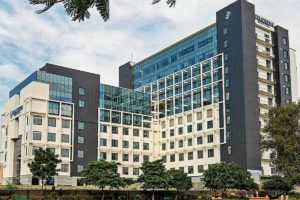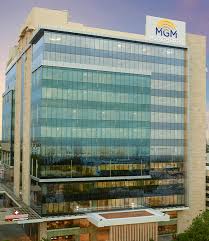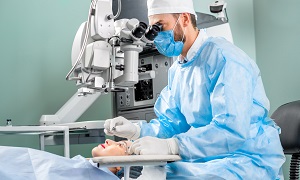Best Doctors in India for Diabetic Retinopathy Treatment
- Opthalmologist, Chennai, India
- Over 26 years’ experience
Profile Highlights:
- Dr. Pratik Ranjan Sen is a specialist in Ophthalmology and serves as an Ophthalmologist – Consultant at Apollo Hospitals, Chennai.
- He has performed over 8000 Retinal detachment and other Vitreo retinal disorder surgeries.
- Dr. Pratik Ranjan Sen considers his profession a mission and is dedicated to his work. Due to this, he has gained enough trust and recommendations from his patients.
- Ophthalmologist, Chennai, India
- Over 21 years’ experience
Profile Highlights:
- Dr. Viswanathan P is one of the best eye surgeons in India having an overall experience of 21 years.
- He is a qualified doctor from the Tamil Nadu University of India and possesses a degree in MBBS and MS.
- One can visit him for routine eye check-ups or retina examinations and services like eye surgery, retina surgery, cataract surgery, etc.
- Ophthalmologist, Gurugram, India
- Over 13 years’ experience
Profile Highlights:
- Dr. Svati Bansal is an esteemed consultant and practitioner of ophthalmology in Gurugram.
- Her specialty lies in orbit and oculoplasty, ocular oncology, ocular trauma, and neuro-ophthalmology.
- She has fellowships in neuro-ophthalmology and ocular motility, oculoplasty, and facial aesthetics, and ocular oculoplastic and ocular oncology.
- Ophthalmologist
- Over 10 years' experience
Profile Highlights:
- Dr. Amit Jain is an experienced Ophthalmologist based in Mumbai, who specializes in treating patients with eye issues, particularly those related to Vitreo-Retina, Uvea, and ROP.
- He is an expert in employing the most recent techniques in eye surgery to address conditions like diabetes that damage the eyes and correct issues with the back of the eye.
- With more than 10 years of expertise, Dr. Amit Jain has made a name for himself as a leading expert in the field of eye care.
- He completed his medical training in Ophthalmology at the Dr. Rajendra Prasad Centre for Ophthalmic Sciences at AIIMS in New Delhi, a renowned institute for eye treatment. Later, he went on to pursue long term clinical fellowship in Vitreoretina at Sanskara Netralaya in Kolkata and Chennai.
- He started his professional career at Shri Ganapati Netralaya in Jalna, Maharashtra as an Associate Consultant in the department of Vitreoretina and Uvea services. And now, he serves as a Consultant in the Department of Ophthalmology at Fortis Hospital, Mulund.
- Apart from being a medical practitioner, Dr. Jain also enjoys imparting information and knowledge among young minds. He mentors aspiring medical professionals who wish to focus on eye care.
- Several of his works on the topic of eyes have been published in prestigious medical publications. Additionally, he often speaks at medical conferences where eye specialists from throughout the nation get together to exchange knowledge.
Best Hospitals in India for Diabetic Retinopathy Treatment
Pushpawati Singhania Hospital & Research Institute, New Delhi
- City: New Delhi, India
Hospital Highlights:
- Established in 1996, Pushpawati Singhania Research Institute is one of the top hospitals in the NCR region, as well as one of the top facilities in India for gastroenterology. The hospital is one of South Asia’s first institutes in medical and surgical treatment for diseases related to digestion.
- The hospital is equipped with state-of-the art facilities coupled with the latest equipment as well as renowned consultants from various parts of India as well as other parts of the world.
W Pratiksha Hospital, Gurgaon
- City: Gurugram, India
Hospital Highlights:
- W Pratiksha Hospital, Gurugram, is one of the best hospitals in the NCR region. It is also a top hospital in India for IVF. Since its inception, the hospital has performed over 5500 successful IVFs. The hospital also specializes in gynecology.
- With over 20 years of experience in providing quality healthcare, the hospital is known as one of the most trusted and valued health providers in India.
- Equipped with world-class medical facilities and advanced technology, the hospital’s doctors and clinicians also have a track record of delivering excellent results. The hospital is also known for focusing on preventive well-being as much as on curative treatment.
- The hospital has earned the trust of its patients, by providing the best available treatments at affordable costs.
Narayana Superspeciality Hospital, Gurugram
- City: Gurugram, India
Hospital Highlights:
- Situated near DLF Cyber City, Gurugram, Narayana Superspecialty Hospital is one of the top medical facilities in the Delhi NCR region, catering to the needs of the people. Known for its commitment to quality medical care and patient service, the hospital is a state-of-the-art facility with planned and well-equipped sections, which includes a spacious OPD area as well as comfortable patient rooms.
- It is the closest super-specialty hospital from Indira Gandhi International Airport towards Gurugram, and also the nearest super specialty hospital from DLF Cyber City. It is also close to major residential areas in Gurugram.
- It is part of the renowned Narayana Health Group. Established in 2000, by Dr. Devi Shetty, a renowned cardiac surgeon, it has grown to be one fo India’s leading healthcare groups.
Sir Ganga Ram Hospital, New Delhi
- City: New Delhi, India
Hospital Highlights:
- Sir Ganga Ram Hospital, New Delhi is known to provide the latest medical procedures with the latest technology in all of its units.
- The hospital has a team of reputed doctors, nurses, and healthcare professionals that ensure that patients receive quality care at affordable costs.
- Staffed with a team of highly qualified doctors, dedicated nurses, and paramedical and non-medical staff, the hospital aims to lead in healthcare delivery, medical education, training, and research.
- As per the vision of the founder, the hospital also provides free treatment to the economically weaker sections of society.
- Sir Ganga Ram Hospital also provides training to young doctors under the Diplomate in National Board(DNB) program. The DNB program at the hospital was started in 1984 and it is known for currently running the maximum number of DNB specialties in the country. It also has the distinction of having the first bone bank in India.
KIMS Hospital, Hyderabad
- City: Hyderabad, India
Hospital Highlights:
- KIMS Hospital (a brand name of Krishna Institute of Medical Sciences) is one of the largest and best multi-speciality hospitals in Hyderabad. The hospital provides various treatments to an enormous number of patients.
- The hospital has a capacity of more than 3000 beds. KIMS Hospitals offers different healthcare services in more than 25 specialities and super specialities.
- The hospital is equipped with modern medical equipment and technology. It has robotic equipment to provide minimal invasive techniques for patients.
- The hospital is aimed at providing world-class healthcare facilities and services at an affordable cost for patients.
- The various specialities and departments of the hospital include neurosciences, gastroenterology & hepatology, robotic science, reproductive sciences, dental science, oncological sciences, organ transplantation, heart and lung transplantation and mother and child care.
Fortis Hospital, Shalimar Bagh
- City: New Delhi, India
Hospital Highlights:
- Fortis Hospital in Shalimar Bagh is a multi-super specialty hospital that strives to provide world-class patient care by leaving no stone unturned.
- Fortis, Shalimar Bagh, with 262 beds and a 7.34-acre footprint, provides the best level of medical care through its team of doctors, nurses, technicians, and management professionals.
Reliance Hospital, Mumbai
- City: Mumbai, India
Hospital Highlights:
- Reliance Hospital is one of the best super-specialty care hospitals in Navi Mumbai.
- The main purpose of this hospital is to become a trustworthy place for the best health and hope for society. The hospital is well connected to the suburbs of Mumbai and Navi Mumbai.
- The hospital has various specialty departments, viz., Accident & Emergency, Anesthesiology, Dental Services, Dermatology, Diabetology, Dietetics Nutrition, Endocrinology, ENT, Gastroenterology, General Surgery, Gynaecology And Obstetrics, Hepato Pancreato Biliary Surgery, Infectious Disease, Internal Medicine, Interventional Radiology, Laboratory Medicine, Minimal Access Laparoscopic Surgery, Nephrology, Neurosciences, Opthalmology, Orthopaedics, Paediatrics, Pain Management Palliative Care, Physical Medicine Rehabilitation, Plastic And Reconstructive Surgery, Psychiatry, Pulmonary Medicine, Radiology, Rheumatology, Transplant, Urology Andrology, Vascular Surgery
Lilavati Hospital & Research Centre, Mumbai
- City: Mumbai, India
Hospital Highlights:
- Lilavati Hospital & Research Centre is India’s premier multi-speciality tertiary care hospital and has been recognised as a global medical excellence centre.
- Lilavati Hospital & Research Centre has built an unrivalled level of trust with its patients over the years, thanks to a solid foundation that comprises cutting-edge facilities, the best medical competence, research, education, and charity endeavours.
- The hospital is quite proud of the fact that it now serves patients from all kinds of backgrounds, not just from the United States but from all around the world.
- The hospital has a total of 323 beds, one of the largest Intensive Care Units (ICUs), 12 Operation Theatres with modern amenities, over 300 consultants, and almost 1,800 personnel.
Venkateshwar Hospital, Dwarka, New Delhi
- City: New Delhi, India
Hospital Highlights:
- State-of-the-art technology and devoted healthcare professionals have been brought together under one roof at Venkateshwar Hospital to provide genuine medical care. The hospital’s professionals work together as a team to deliver the best possible treatment to their patients, using the most sophisticated equipment and information technology.
- Venkateshwar Hospital’s mission is to attain global excellence in healthcare by employing evidence-based, ethical clinical practices and cutting-edge technology by a team of highly skilled experts.
MGM Healthcare, Chennai
- City: Chennai, India
Hospital Highlights:
- Located in Chennai, India, MGM Healthcare is a top multispecialty hospital that provides all medical services under one roof.
- Since its founding in 2019, MGM Healthcare has quickly become a leading national referral centre, creating several innovative flagship initiatives.
- MGM Healthcare combines next-generation medical and digital technologies to provide better patient results.
- With 12 centres of excellence, more than 400 inpatient beds, 100 intensive care unit beds, and 24/7 emergency care, MGM Healthcare leaves no chance in redefining the patient experience in Chennai.
- MGM Healthcare boasts 250+ expert doctors across 30+ departments, including Cardiology, Pulmonology, Neurology, Obstetrics & Gynaecology, and more.
- They house 12 specialized Centres of Excellence, including Neurosciences, Orthopaedics, and Multi-Organ Transplantation.
- Their team of doctors, nurses, and paramedics works together to give every patient individualized treatment.
DIABETIC RETINOPATHY
Diabetic retinopathy is a condition that occurs due to damage to the blood vessels of the retina in people suffering from diabetes. If you have type 1 or type 2 diabetes, and a long history of uncontrolled blood sugar levels, you might develop diabetic retinopathy.
Though the condition generally starts with a mild vision loss, eventually you might even lose your sight. Diabetic retinopathy is known to be the most common eye disease among people who suffer from diabetes.
Symptoms
Although you might not have any symptoms in the early stages of diabetic retinopathy, as the condition progresses, some of the symptoms might include:
- Blurred vision
- Fluctuating vision
- Floaters
- Dark or empty areas in your vision
- Impaired color vision
- Vision loss
This condition is known to generally affect both eyes. If you are suffering from diabetes, managing it carefully is one of the best ways to prevent loss of vision. Even if your vision seems fine, see your eye doctor once every year for an examination.
Pregnancy might also worsen diabetic retinopathy, and therefore if you are pregnant, additional eye exams might be recommended by your doctor.
If your vision changes suddenly or becomes blurry, spotty, or hazy, then contact your eye doctor right away.
Causes & risk factors
High levels of sugar in your blood over long periods can lead to diabetic retinopathy. The excess sugar causes damage to the blood vessels supplying your retina with blood. High blood pressure is a risk factor, as well, for retinopathy.
The retina is a layer of tissue in the back of your eye, which helps to change the images that the eye sees into nerve signals so that the brain can understand them. When the retina’s blood vessels undergo any damage, they can get blocked. This cuts off some of the blood supply of the retina. This loss of blood flow can even lead to other, weaker blood vessels to grow and these new blood vessels may leak and also create scar tissue which can lead to loss of vision.
The longer you suffer from diabetes, the higher are your chances of developing diabetic retinopathy. People who suffer from diabetes for over thirty years generally show signs of retinopathy. Managing your diabetes can generally slow the progression.
Although any person with diabetes is at risk of diabetic retinopathy, the risk becomes higher if the person:
- Has uncontrolled blood sugar levels
- Has high cholesterol
- Has high blood pressure
- Is suffering from diabetes for a very long time
- Is pregnant
- Smokes regularly
Diagnosis
Eye exam
- Scarring
- Leaking of the blood vessels
- Blocked blood vessels
- Changes to the lens
- Retinal detachment
- Damage to the nerve tissue
Fluorescein angiography test
They may also perform a fluorescein angiography test, which involves injecting a dye into your arm, which allows them to track how the blood flows in your eye. They will need to take pictures of the dye circulating inside your eye so that they are able to determine which vessels are blocked, leaking, or broken.
OCT exam
An OCT (optical coherence tomography) exam might be used as well. It uses light waves in order to produce images of the retina. These images let your doctor determine the thickness of your retina and let him/her known if any fluid has accumulated in it.
Treatment
For people suffering from early diabetic retinopathy, treatment options are limited. Your doctor might want to perform regular eye exams, in order to monitor the eye health just in case, treatment becomes necessary. An endocrinologist can also help you slow the progression of the condition by helping you manage your diabetes.
For people suffering from advanced diabetic retinopathy, the treatment options depend on the type and severity of the condition. Treatment can be of various types.
Photocoagulation surgery
Scatter photocoagulation
Scatter photocoagulation is a method that involves using a laser to burn hundreds of tiny holes in the eyes so that the risk of blindness is reduced.
Focal photocoagulation
Focal photocoagulation, meanwhile, involves using a laser to target a specific leaky vessel in the macula so that macular edema doesn’t worsen.
Vitrectomy
Vitrectomy is another method of treatment that involves removing scar tissue and cloudy fluid from the vitreous fluid of the eye.
Complications
If left untreated, diabetic retinopathy might lead to several complications.
When blood vessels bleed into the vitreous, the main jelly that fills the eye, this is called vitreous hemorrhage. The symptoms include floaters, in mild cases, but in severe cases, symptoms can include vision loss, as the blood in the vitreous blocks any light from entering the eye. If the retina remains undamaged, then the bleeding in the vitreous is able to resolve itself. In some cases, diabetic retinopathy might even cause a detached retina. This complication can happen if scar tissue pulls the retina away from the back of the eye.
The abnormal blood vessels which are associated with this condition stimulate the growth of scar tissue as well, which can pull the retina away from the back of the eye. This is known as retinal detachment. This can cause spots floating in your vision, flashes of light, or in some cases, severe vision loss.
In some cases, blood vessels might grow in the front part of your eye, and this might interfere with the normal flow of fluid out of the eye, causing pressure in the eye to build up. This is known as glaucoma. This pressure can damage the nerve carrying images from your eye to your optic nerves.
Diabetic retinopathy, glaucoma, or a combination of both can lead to you losing your vision completely.
Prevention
Diabetic retinopathy can’t be always prevented. However, regular eye examinations, as well as proper control of your blood sugar and blood pressure, as well as an early intervention for vision problems can help to prevent severe vision loss.
If you smoke or use any other kind of tobacco, quitting is the best way to prevent diabetic retinopathy. Ask your doctor if you need help in quitting.
















